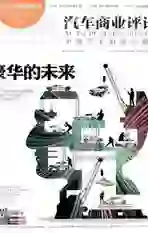Impressions from this year′s IAA
2015-04-13
The worlds largest and most important trade fair for mobility, transport and logistics - the IAA in Hanover,Germany -has just come to an end. This years IAA was all about commercial vehicles, since the focus is switching biannually between passenger and commercial vehicles. As the slogan “Driving the future” implies the IAA commercial vehicle was this time trying to show how the industry will develop in future, rather than unveiling myriads of new models, which is normally the case at the IAA passenger cars.
This years main topics were operational efficiency and vehicle-to-vehicle connectivity. Each OEM was eager to showcase his latest efforts while at the same time avoid being associated with environment pollution, a stigma that in Europe is unfortunately often attributed to trucks. The approaches OEMs chose to improve efficiency ranged from designing cleaner, more efficient powertrains up tooverall efficiency improvements through lightweight design and improved aerodynamics. It comes as no surprise that given this narrow focus on operational efficiency driving-assistance systems were marketed as measures to further lower fuel consumption. The next generation of driving-assist systems come close to fully autonomous driving, but more on this topic later.
Connectivity was the second dominating topic on this years show floor. The truck industry is determined to establish vehicleto-vehicle communication as a standard in the near future. By creating a persistent connection between vehicles logistics companies and freight customers will be able to initiate the next round of logistics optimizations. Although this technology is a bless in several fields it could also become a curse for some groups. This high level of transparency offers many opportunities for optimization but there are limits in legal and privacy to consider before establishing such a solution. Drivers could feel unease if their personal driving behaviour is transmitted to 3rd parties or in worst case, if they are punished for inefficient driving.
Judging from media interest and buzz on the show floor this years highlight was definitely Daimler with the presentation of its future truck. Daimlers Mercedes-Benz Trucks brand presented his futuristic-looking“Future Truck 2025”, a self-driving vehicle, which does not depend on any external data. By incorporating all necessary systems and databases in the vehicle itself, Daimler was able to offer a degree of autonomous driving which was up until recently only seen in Googles experimental cars.endprint
What is interesting at Daimlers approach is the fact that there was very little new or groundbreaking technology inside the Future Truck 2025. Most of the technology such as cameras and sensor arrays to substitute Mirrors exist already today. What Daimler did in a very clever way is integrating these technologies and thus providing a solution that is more powerful than the sum of its parts.
After seeing all this systems a natural reaction on the show was: “What is the driver actually doing?”. In Daimlers future Truck the driver becomes the vehicle manager who is supervising the driving process and has time to perform nondriving activities such as administrative work to reduce downtimes.
While Daimlers technology is a big chance to improve safety and reduce accidents there is also a big challenge in convincing existing customers to pay a premium for autonomous driving. Transportation companies have a razor-sharp focus on TCO which typically means efficient and durable vehicles with a good overall cost performance. As long as the price premium for this technology is as high as it is today it will be very hard to convince fleet operators to upgrade. However with the increasing pressure on commercial vehicle makers to further reduce CO2 and fuel consumption, I could see autonomous highway driving become standard in the EU for trucks in about 10 to 15 years. Unlike passenger cars, where most of the autonomous driving would happen inside cities and poses immense technical and legal challenges, long-haul transport is a use-case with much lower risk attached.
But I think the main message Daimler wanted to show with its commitment to autonomous driving was something entirely different: I took it as a clear message that Daimler is not content in being a fast follower in the commercial vehicle industry, where it is the global leader. It is rather ready and able to toe-to-toe with Google, which gained lots of attention recently for its self-driving cars. Daimlers example shows that it is wrong to disregard the German automotive industry just because they are not conducting their autonomous driving experiments as publicly visible as Google. After all Daimler wants to lead the industry not only in terms of sales numbers but also in terms of technology, as the CEO of their truck group, Dr. Wolfgang Bernhard, repeatedly emphasized.
A very positive sign for the state of the Chinese automotive industry was the strong presence of commercial vehicle brands and suppliers at the IAA. I was very glad to see the number of OEMs and suppliers had grown that strong since the IAA 2012. DONGFENG, which for the first time had its own booth at the show, gained the most media attention.
Among the presented vehicles the KX, a heavy duty truck, gained lots of attention as many show visitors, OEMs and media alike, were eager to get a first-hands experience of a Chinese truck. Dongfengs KX will definitely heat up competition in emerging markets and I think it was very clever to not position the KX as a truck for the west european market, which is highly competitive and regulated, but rather focus on the next growth markets. The low entry price for the KX will definitely help in building a customer base, even though there is no after sales network currently available. In the end its just a matter of time until Dongfeng, FOTON or another Chinese commercial vehicle brand will establish itself as the first major Chinese player in the international truck market.endprint
